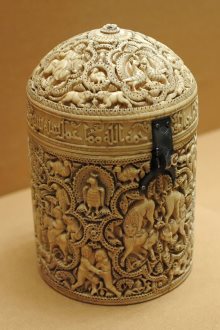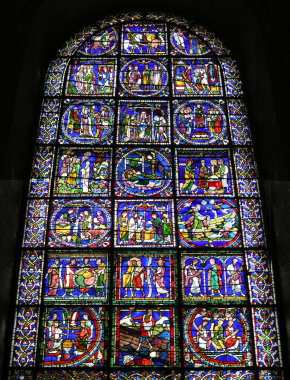
Byzantine Mosaic
The transmission of Byzantine art and architecture to Western Europe was facilitated by the Crusading movement and the development of Mediterranean trade.
Decorative arts traveled to the West, notably tapestries, jewelry, and furniture, and these works were received as privileged and, thus, influenced European styles and tastes. A brisk trade in relics inspired construction of churches and reliquaries. The relic trade alone ensured that other arts were transmitted to Western Europe.
al-Andalus (Islamic Spain) was a great cultural center of the Middle Ages. Besides the great universities, which taught philosophies and sciences yet unknown in Europe, the territory was an equally vital center for art.

Pyxis of al-Mughira, Madinat al-Zahra, 968, today in the Louvre.
Many techniques were employed in the manufacture of objects. Ivory was used extensively for the manufacture of boxes and caskets. The pyxis of al-Mughira is a masterwork of the genre.
In metalwork, large sculptures in the round, normally rather scarce in the Islamic world, served as elaborate receptacles for water or as fountain spouts.
The art world was also transformed by improvements in papermaking. Previously, artists had to practice their techniques and develop their drawing abilities on canvases that they painted over and over again, so most paintings were actually lost - hidden under layers and layers of new paint.
When paper became available as a cheap type of canvas
, artists could go wild practicing their sketching, and
now these sketches could be saved. For the first time, drawing became an important art form in itself.
Mosaics
Mosaics are illustrations created by small bits of colored glass or stone. Sometimes flecks of gold are used to make the whole mosaic sparkle with light. If the tiles are cut at uneven angles, the picture appears to ripple in a wave movement.
Mosaic is the art of creating images with small pieces of colored glass, stone or other material. It may be a technique of decorative art, an aspect of interior decoration or of cultural and spiritual significance as in a cathedral. Small tiles or fragments of pottery (known as tesserae, diminutive tessellae) or of colored glass or clear glass backed with metal foils are used to create a pattern or picture.
Mosaics were more central to Byzantine culture than to that of Western Europe. Byzantine church interiors were generally covered with golden mosaics. Mosaic art flourished in the Byzantine Empire from the 6th to the 15th century. The 9th and 10th century mosaics of the Hagia Sophia in Constantinople are truly classical Byzantine artworks. These varied artistic traditions were transmitted to Italy and Western Europe in the 14th and 15th centuries.

The Poor Man's Bible window at Canterbury Cathedral, 13th century.
Stained Glass
Throughout its thousand - year history, the term stained glass
was applied almost exclusively to the windows of churches, cathedrals, and other significant buildings.
As a material, stained glass is glass that has been colored by adding metallic salts during its manufacture. The colored glass is crafted into stained glass windows in which small pieces of glass are arranged to form patterns or pictures, held together (traditionally) by strips of lead and supported by a rigid frame.
In the 8th century, the Muslim alchemist Jabir ibn Hayyan scientifically described 46 original recipes for producing colored glass in Kitab al-Durra al-Maknuna (The Book of the Hidden Pearl). Jabir also described the production of high quality colored glass cut into artificial gemstones.
Stained glass, as an art form, reached its height in the Middle Ages when it became a major pictorial form and was used to illustrate the narratives of the Bible to a largely illiterate populace.
Many large windows have withstood the test of time and remained substantially intact since the late Middle Ages.
In Western Europe, they constitute the major form of pictorial art to have survived. In this context,
the purpose of a stained glass window is not to allow those within a building to see the world outside or even
primarily to admit light but rather to control it. For this reason stained glass windows have been described as
illuminated wall decorations
.
